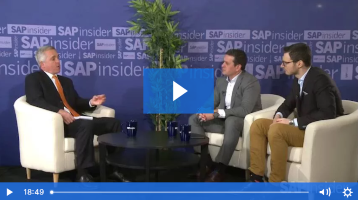Digitization and the Intelligent Enterprise
Q&A with Tanja Rueckert, SAP Executive Vice President, Line of Business Digital Assets and IoT
Q: What do you find most interesting about the state of IoT in business today?
Most of us underestimate what is possible with machine and device intelligence and the huge opportunities we have with all the information, signals, and connectivity that are present in a digital economy. It’s difficult to fully estimate how big this is for industrial, consumer, and other businesses, and that’s what makes it so fascinating; we are at the precipice of being able to drive a new era of efficiency and automation, creating insights and business models we’ve never had before.
We’ve seen this already in many industries. In the farm-to-fork agriculture model, asset intelligence and business process connectivity have helped to reshape some longstanding business processes and drive efficiencies across the entire company value chain. Sensor technology is being used to run fleets of self-driving tractors that optimize crop harvests. Opportunity extends far beyond one industry, and beyond even just SAP. And those opportunities don’t come around often.
Q: What is top on your to-do list in your new role?
The top priorities are innovation, thought leadership, business trends, customer transformation, customer adoption, and ecosystem. We have consolidated all of the IoT teams, including supply chain management, transportation, and logistics. This was done to help drive innovation by centralizing how different lines of business collaborate together and work more in start-up mode — fast, agile, and highly focused on domain-specific IoT solutions and domain-independent features, bundled as reusable IoT application services. We can now more easily connect assets to a back-end digital core with SAP S/4HANA, and this really opens up innovative opportunities for companies to take another look at their business processes and business models to see how they might be altered to capitalize on a more digital framework.
Customer adoption is also very important, and while many customers are currently involved in IoT projects, we do still see many customers unsure about how to begin a digital transformation journey.
We must also grow our ecosystems; partners are always important, and this is especially true when it comes to IoT technologies. SAP does not have a monopoly on bringing innovation to the market; no one company can do this on its own. We are also seeing a convergence of operational technology (OT) and IT coming together in a symbiotic partnership that benefits both the business and the consumer.
Q: What are the biggest customer misconceptions about IoT, Industry 4.0, and digital transformation?
One potentially dangerous misconception is that IoT is a passing phenomenon or craze that does not warrant serious attention. The truth is, it will be very difficult for companies that are not leaders in IoT and machine learning to catch up and leverage these tools to a competitive advantage.
However, companies do not have to reinvent everything at once. Instead, they can start small, tackling one process or a series of processes and seeing where it takes them. They could begin with route optimization for more efficient deliveries, for example, or a shift from plant maintenance to a more predictive model. People wonder about the complexities from increased automation, or how changes will affect the workforce, when in fact, changes brought on by IoT can simplify complex processes and create job opportunities.
Another misconception is that privacy and data security will be compromised with mission-critical data flowing across lines of business in a cloud-based deployment. SAP has invested heavily in IoT security to enable secure data transmissions, and we’re involved in many IoT standards committees. For example, I’m co-chair of a steering committee that is helping to drive an interoperability standardization framework and a high level of security that will ultimately help SAP customers overcome these concerns.
Q: What is the right approach to bringing IoT and Industry 4.0 solutions to the business?
First, a company should go through its processes and consider how they relate to a typical IoT scenario. By doing this, it can more easily see which tools it will need to bring connected assets and machine learning to the business most effectively. Having an IoT or Industry 4.0 mindset is less about the technology than it is about connecting with the customer. I truly believe that there are no more limits placed on the business by technology; the differentiator, then, is thinking not just about making products more inexpensively or driving process efficiencies, but also about significantly improving customer experiences. This is what sensor technology and incorporating IoT into day-to-day business operations can achieve.
One of the reasons we should think about the big picture from the customer perspective is that sensors are becoming more intelligent, possessing capabilities we didn’t have before. They are not just collecting data; rather, they are sharing data across a network of connected assets for aggregation intelligence. This highlights the importance of integrating back-end systems to a connected IoT platform.
Q: What do partners bring to the IoT ecosystem to help customers reach their digital potential?
From the perspective of helping to deliver pre-integrated solutions, the importance of partners cannot be overstated for a data-driven organization. SAP works continuously with partners to bring innovation to the customer. Partners also bring in an industry-specific flavor, and our industry teams then work with partners to customize some SAP applications to reflect differences in industry standards.
Software implementation is another dimension where partners add value. Specifically in the IoT space, while we have several standard solutions, there’s often a competitive edge for customers who shy away from the standard and look for partners who have developed a customization jointly with SAP or who have tweaked the system a little bit so they have a competitive advantage.
Q: How different will supply chain management and logistics look as more companies go digital?
I believe it will revolve around a consumer-driven economy. Highly automated factory floors will be very different in the future and configured with the consumer in mind, and there will be nothing separating the top floor from the shop floor. A consumer-driven, high level of automation isn’t that far away; we are already seeing a significant reduction in delivery time expectations where a customized product is picked and shipped the same day it is ordered, and the transaction is updated in real time into a back-end system with little-to-no human involvement. 3D printing will also shorten delivery windows and help to minimize production downtime as parts or materials can be printed with a signal from the asset that requires maintenance.
This isn’t a far-off future, but rather things companies are doing today to stay competitive. SAP offers joint workshops designed to help organizations determine where that value can best be extracted. Is the goal to lower maintenance costs by transitioning to a predictive maintenance model? Reduce energy consumption? Drive new or more personalized products or services? In a joint workshop, we can go through many different scenarios and address these topics from a customer-specific lens. Companies should start small, start now, and determine what will create the most value.
Q: What sets SAP apart as the preferred partner to help companies achieve digital transformations?
SAP is the only company that can not only map the data from the device or asset to the business back end, but then also help to make the necessary business process changes. Because it’s not about just collecting data; a digital transformation requires the ability to make educated, real-time business decisions about what the data tells you, and SAP can close that loop throughout the business even as assets and connected devices become more intelligent. On top of this, SAP provides industry and functional expertise and superior technology with the SAP HANA in-memory database, which can store and analyze all of the smart data a company needs to embrace predictive capabilities.
SAP is also consistently delivering ready-to-deploy, out-of-the box solutions to help companies start their digital journeys. This is happening as IoT becomes more commonplace and custom development is shifting to more standardization. SAP Predictive Maintenance, for example, is a great tool to provide a company with a much greater understanding of its assets. This one solution is a common entryway to bring IoT to the enterprise. By providing an asset-specific history of a machine and combining this with external data, organizations can make much more intelligent decisions concerning scenarios such as scheduling, parts ordering, and tightening the connection between machines and business processes. For a company that is transitioning from selling a product to selling a service, it is critical to keep the assets that provide the service running continuously. SAP Predictive Maintenance provides the ability to be proactive — finding a problem before the problem finds you.
While no digital transformation is the same, each digital transformation journey does share some important components, perhaps none more important than the realization that data is the lifeblood of organizations that wish to compete in a digital economy.








